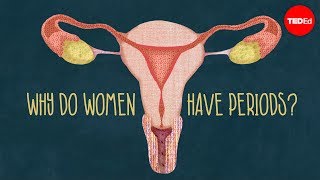(单词翻译:单击)
A handful of species on Earth share a seemingly mysterious trait: a menstrual cycle.
地球上只有极少数的物种有这种神秘的特质:月经周期。
We're one of the select few.
人类是便是这少数物种之一。
Monkeys, apes, bats, humans, and possibly elephant shrews are the only mammals on Earth that menstruate.
猴子、猿、蝙蝠、人类,可能还有象鼩,是地球上仅有的有月经的哺乳动物。
We also do it more than any other animal, even though its a waste of nutrients and can be a physical inconvenience.
人类的月经比其他动物更频繁,即便月经会导致营养流失和身体上的不便。
So where's the sense in this uncommon biological process?
那么这种罕见的生理过程究竟意义何在?
The answer begins with pregnancy.
这要从怀孕说起。
During this process, the body's resources are cleverly used to shape a suitable environment for a fetus,
在怀孕过程中,身体的资源被充分地利用来塑造一个适合胎儿生长的环境,
creating an internal haven for a mother to nurture her growing child.
为胎儿成长提供营养的港湾。
In this respect, pregnancy is awe-inspiring, but that's only half the story.
从这方面来看,怀孕是多么神奇啊,但这只是一方面。
The other half reveals that pregnancy places a mother and her child at odds.
另一方面,怀孕的过程中母体和胎儿也存在冲突。
As for all living creatures, the human body evolved to promote the spread of its genes.
和其他所有生物一样,人类身体进化的目的是更好地延续物种基因。
For the mother, that means she should try to provide equally for all her offspring.
对母亲而言,这意味着她应该给她所有的后代提供相同的条件。
But a mother and her fetus don't share exactly the same genes.
但母亲和胎儿的基因不是完全相同的。
The fetus inherits genes from its father, as well,
胎儿还继承了其父亲的基因,
and those genes can promote their own survival by extracting more than their fair share of resources from the mother.
这些基因为了生存,会向母亲索取更多的资源。
This evolutionary conflict of interests places a woman and her unborn child in a biological tug-of-war that plays out inside the womb.
这种进化中的利益冲突,让女性和她腹中的孩子在子宫内展开一场生理上的拔河比赛。
One factor contributing to this internal tussle is the placenta,
这场比赛的成因之一是胎盘,
the fetal organ that connects to the mother's blood supply and nourishes the fetus while it grows.
胎盘是连接胎儿和母体血液系统的器官,它为胎儿提供发育需要的营养。
In most mammals, the placenta is confined behind a barrier of maternal cells.
大多数哺乳动物的胎盘被母体内的一层细胞屏障包围。
This barrier lets the mother control the supply of nutrients to the fetus.
这层屏障让母体能控制给胎儿的营养供应。

But in humans and a few other species,
但对于人类和其他少数物种来说,
the placenta actually penetrates right into the mother's circulatory system to directly access her blood stream.
胎盘实际上直接进入了母体的循环系统,直接接触母体的血液。
Through its placenta, the fetus pumps the mother's arteries with hormones
通过胎盘,胎儿向母体的动脉释放荷尔蒙,
that keep them open to provide a permanent flow of nutrient-rich blood.
这使母体的动脉扩张,运送营养丰富的血液。
A fetus with such unrestricted access can manufacture hormones to increase the mother's blood sugar,
这样无限制的接触,胎儿能通过控制激素来增加母体血糖,
dilate her arteries, and inflate her blood pressure.
扩张母体动脉,并提高母体血压。
Most mammal mothers can expel or reabsorb embryos if required,
在必要的情况下,大多数哺乳动物的母体能排出或者再吸收胚胎,
but in humans, once the fetus is connected to the blood supply, severing that connection can result in hemorrhage.
但是对人类来说,一旦胎儿连接到血液供应,切断了这种连接会导致严重内出血。
If the fetus develops poorly or dies, the mother's health is endangered.
如果胎儿发育不良或死亡,则会危及母亲的健康。
As it grows, a fetus's ongoing need for resources can cause intense fatigue,
胎儿发育和对营养的持续需求会使母亲极其疲惫,
high blood pressure, and conditions like diabetes and preeclampsia.
血压升高,并可能出现糖尿病和先兆子痫等状况。
Because of these risks, pregnancy is always a huge, and sometimes dangerous, investment.
因为这些风险的存在,怀孕是一项重大而危险的投资。
So it makes sense that the body should screen embryos carefully to find out which ones are worth the challenge.
因此身体有理由仔细筛选胚胎,只留下那些值得为之冒险的胚胎。
This is where menstruation fits in.
月经则随之产生了。
Pregnancy starts with a process called implantation, where the embryo embeds itself in the endometrium that lines the uterus.
怀孕始于“着床”这一过程,胚胎把自己嵌入到子宫内膜上。
The endometrium evolved to make implantation difficult so that only the healthy embryos could survive.
子宫内膜不断演化使得着床变得困难,这样只有健康的胚胎能够存活。
But in doing so, it also selected for the most vigorously invasive embryos, creating an evolutionary feedback loop.
但这样一来,它也选择了最有活力的胚胎,创造了一个进化反馈循环。
The embryo engages in a complex, exquisitely timed hormonal dialogue that transforms the endometrium to allow implantation.
胚胎向子宫内膜传递复杂而精细的激素信号,使子宫内膜允许它着床。
What happens when an embryo fails the test?
那么如果胚胎着床失败了呢?
It might still manage to attach, or even get partly through the endometrium.
胚胎可能还会附着在子宫内膜上,甚至部分进入子宫内膜。
As it slowly dies, it could leave its mother vulnerable to infection,
但胚胎慢慢死去时,母体会更容易发生感染。
and all the time, it may be emitting hormonal signals that disrupt her tissues.
它可能还会一直释放激素信号,扰乱母体组织。
The body avoids this problem by simply removing every possible risk.
身体为了避免这个问题,会排出所有可能的危险。
Each time ovulation doesn't result in a healthy pregnancy,
每当排卵未能形成健康胚胎,
the womb gets rid of its endometrial lining, along with any unfertilized eggs, sick, dying, or dead embryos.
子宫都会使整个内膜脱落,同时将未受精的、虚弱的或濒死的胚胎一并排出。
That protective process is known as menstruation, leading to the period.
这个自我保护的过程就是月经周期,其结果就是月经来潮。
This biological trait, bizarre as it may be, sets us on course for the continuation of the human race.
正是这种奇异的生物特性使得人类能一直繁衍下去。


